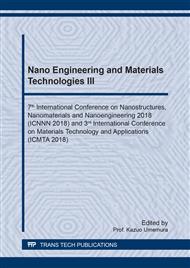p.185
p.190
p.195
p.200
p.207
p.212
p.217
p.222
p.228
Pozzolanic Reactivity of Coal Bottom Ash after Chemically Pre-Treated with Sulfuric Acid
Abstract:
Current trend in construction industry has highlighted the use of silica-rich supplementary cementitious materials from industrial wastes in the production of concrete. Numerous studies have validated the pozzolanic properties of these materials, yet coal bottom ash received only infamous reputation as a pozzolanic material, owing to its low reactivity and heavy metals contaminants. Therefore this study was purposed to enhance the pozzolanic reactivity of coal bottom ash through chemical pre-treatment process. Different concentrations of acids and treatment period were studied to obtain optimum parameters for pre-treatment process. Treated ash was characterized for its chemical oxide composition. Its effect on the hydration of cement was studied through the inclusion as cement replacement material in mortar mixtures. From the chemical oxide compositions, a combination of 0.5 M of H2SO4 and 1 hour soaking duration presented the highest SiO2 proportion in the ash. Its inclusion at 5% (by weight of cement) to replace cement proportion in mortar mixtures was able to enhance the compressive strength of mortar at later age, regardless of its slower strength development in the early age. Utilizing treated coal bottom ash as partial cement replacement material has unlocked new achievement for greener future in construction industry.
Info:
Periodical:
Pages:
212-216
Citation:
Online since:
March 2019
Authors:
Price:
Сopyright:
© 2019 Trans Tech Publications Ltd. All Rights Reserved
Share:
Citation:


